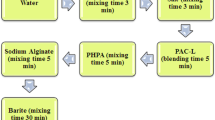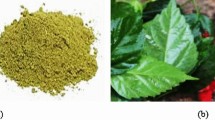Abstract
Knowledge on shale formations which make up almost 70% of the wellbore section is crucial since drilling through shale formations are very problematic. Various mud configurations have been designed to curtail these challenges over the years. One of the approaches in solving this challenge is designing optimum membrane efficient water-based drilling fluids capable of generating high osmotic pressures in shales. A set of integrated experiments have been conducted on selected bio-based plants containing saponin responsible for bio-plants surfactant acting property. The crude extracts containing saponins were used to design a water-based mud and deployed in a series of pore pressure transmission inhibition studies through measurements of membrane efficiency, wettability, and zeta potential analysis measurements. Results indicated that the bio-surfactants can create the much needed high osmotic pressure in shales leading to significantly improved membrane efficiency of the shale of over 80%. The results confirmed the leaky nature of shales as semipermeable membranes and membrane efficiency was found possible to be a function of the saponin concentration. Membrane efficiencies in shales were found to be low with high-permeability shales not showing membrane efficiency at all. Further analysis of the data showed that the flux of ions is a function of the ionic radii, shale permeability, and the cation exchange capacity of the shale. Stability of the shale was sustained to a larger extent by the reduction the drilling fluid water activity ability in creating a high osmotic pressure in shales










Similar content being viewed by others
Abbreviations
- AE:
-
Aralia elata
- CEC:
-
Cation exchange capacity
- CF:
-
Cordyline fruitcosa
- CGD:
-
Company given data
- CH-CMC:
-
Cocoa husk carboxymetylcellulose
- CMC:
-
Critical Micelle concentration
- CMLC:
-
Carboxymethyl cellulose
- CO:
-
Chromolaena Odorata
- DC:
-
Dioscorea cayenensis
- DIW:
-
Deionized water
- F-CO:
-
Flower of Chromolaena odorata
- ME:
-
Membrane efficiency
- Awdf :
-
Test fluid water activity
- Awsh :
-
Pore fluid water activity
- V :
-
Partial Molar Volume of Water
- PV:
-
Panicum virgatum
- R :
-
Gas constant
- R-CO:
-
Root of Chromolaena odorata
- SBDF:
-
Synthetically-based drilling fluids
- S-PV:
-
Stem of Panicum virgatum
- TG:
-
Tectona grandis
- TT:
-
Tribulus terrestris
- ∆P :
-
Differential pressure in sample shale after attaining equilibrium
- T :
-
Absolute temperature (°K),
- LPLT:
-
Low pressure low temperature
- σ :
-
Membrane efficiency
- П:
-
Ideal osmotic pressure
- UCS:
-
Uniaxial compressive strength
- WBDF:
-
Water-based drilling fluid
- HPHT:
-
High-pressure high temperature
References
Zhong, H.; Yang, T.; Yin, H.; Lu, J.; Zhang, K.; Fu, C.: Role of Alkali type in chemical loss and ASP-flooding enhanced oil recovery in Sandstone formations. SPE Reserv. Eval. Eng. 23, 431–445 (2020). https://doi.org/10.2118/191545-PA
Guo, T.; Tang, S.; Liu, S.; Liu, X.; Xu, J.; Qi, N.; Rui, Z.: Physical simulation of hydraulic fracturing of large-sized tight sandstone outcrops. SPE J. 2020, 1–22 (2020). https://doi.org/10.2118/204210-pa
Oseh, J.O.; Norddin, M.N.A.M.; Muhamad, H.N.; Ismail, I.; Gbadamosi, A.O.; Agi, A.; Ismail, A.R.; Blkoor, S.O.: Influence of (3–Aminopropyl) triethoxysilane on entrapped polypropylene at nanosilica composite for shale swelling and hydration inhibition. J. Pet. Sci. Eng. 194, 107560 (2020). https://doi.org/10.1016/j.petrol.2020.107560
Keshavarz Moraveji, M.; Ghaffarkhah, A.; Agin, F.; Talebkeikhah, M.; Jahanshahi, A.; Kalantar, A.; Amirhosseini, S.F.; Karimifard, M.; Mortazavipour, S.I.; Sehat, A.A.; Arjmand, M.: Application of amorphous silica nanoparticles in improving the rheological properties, filtration and shale stability of glycol-based drilling fluids. Int. Commun. Heat Mass Transf. 2020, 115 (2020). https://doi.org/10.1016/j.icheatmasstransfer.2020.104625
Rahman, M.T.; Negash, B.M.; Moniruzzaman, M.; Quainoo, A.K.; Bavoh, C.B.; Padmanabhan, E.: An Overview on the potential application of ionic liquids in shale stabilization processes. J. Nat. Gas Sci. Eng. 81, 103480 (2020). https://doi.org/10.1016/j.jngse.2020.103480
van Oort, E.: On the physical and chemical stability of shales. J. Pet. Sci. Eng. 38, 213–235 (2003). https://doi.org/10.1016/S0920-4105(03)00034-2
Schlemmer, R.; Patel, A.; Friedheim, J.; Young, S.; Bloys, B.: Progression of Water-based fluids based on amine chemistry—can the road lead to true oil mud replacements? AADE-03-NTCE-36 AADE 2003. Natl. Technol. Conf. Practical Solut. Drill. Challenges. 2003, 1–14 (2003)
AL-Bazali, T.: The impact of water content and ionic diffusion on the uniaxial compressive strength of shale. Egypt. J. Pet. 22, 249–260 (2013). https://doi.org/10.1016/j.ejpe.2013.06.004
Lin, A.; Alali, M.; Almasmoom, S.; California, S.; Samuel, R.: IADC/SPE-189598-MS wellbore instability prediction using adaptive analytics and empirical mode decomposition. Soc. Petrol. Engineers 2018, 1–10 (2018)
May, P.; Deville, J.; Miller, J.; Burrows, K.: Environmentally acceptable shale inhibitors for high performance water-based muds. Int. Pet. Technol. Conf. 2020, 3 (2020). https://doi.org/10.2523/iptc-19902-ms
Quainoo, A.K.; Negash, B.M.; Bavoh, C.B.; Ganat, T.O.; Tackie-Otoo, B.N.: A perspective on the potential application of bio-inhibitors for shale stabilization during drilling and hydraulic fracturing processes. J. Nat. Gas Sci. Eng. 79, 103380 (2020). https://doi.org/10.1016/j.jngse.2020.103380
Aslannezhad, M.; Keshavarz, A.; Kalantariasl, A.: Evaluation of mechanical, chemical, and thermal effects on wellbore stability using different rock failure criteria. J. Nat. Gas Sci. Eng. 78, 103276 (2020). https://doi.org/10.1016/j.jngse.2020.103276
Cavanagh, A.: Benchmark calibration and prediction of the Sleipner CO 2 plume from 2006 to 2012. Energy Procedia. 37, 3529–3545 (2013). https://doi.org/10.1016/j.egypro.2013.06.246
Mody, F.K.; Hale, A.H.: Borehole-stability model to couple the mechanics and chemistry of drilling-fluid/shale interactions. J. Pet. Technol. 45, 1093–1101 (1993). https://doi.org/10.2118/25728-PA
Horsrud, P.; Bostrom, B.; Sonstebo, E.F.; Holt, R.M.: Interaction between shale and water-based drilling fluids: laboratory exposure tests give new insight into mechanisms and field consequences of KCl contents. Proc. SPE Annu. Tech. Conf. Exhib. 1998, 215–225 (1998). https://doi.org/10.2118/48986-MS
Zhang, J.; Chenevert, M.E.; AL-Bazali, T.; Sharma, M.M.: A new gravimetric—swelling test for evaluating water and ion uptake in Shales. SPE Annu. Tech. Conf. Exhib. 2004, 5 (2004). https://doi.org/10.2118/89831-MS
Meng, X.; Zhang, Y.; Zhou, F.; Chu, P.K.: Effects of carbon ash on rheological properties of water-based drilling fluids. J. Pet. Sci. Eng. 100, 1–8 (2012). https://doi.org/10.1016/j.petrol.2012.11.011
Simpson, J.P.; Walker, T.O.; Jiang, G.Z.: Environmentally acceptable water-base mud can prevent shale hydration and maintain borehole stability. SPE Drill. Complet. 10, 242–249 (1995). https://doi.org/10.2118/27496-PA
Mao, H.; Qiu, Z.; Shen, Z.; Huang, W.: Hydrophobic associated polymer based silica nanoparticles composite with core-shell structure as a filtrate reducer for drilling fluid at utra-high temperature. J. Pet. Sci. Eng. 129, 1–14 (2015). https://doi.org/10.1016/j.petrol.2015.03.003
Oort, E.V.: A novel technique for the investigation of drilling fluid induced borehole instability in shales. Rock Mech. Petrol. Eng. 1994, 293–308 (1994)
Moslemizadeh, A.; Shadizadeh, S.R.: A natural dye in water-based drilling fluids: Swelling inhibitive characteristic and side effects. Petroleum. 3, 355–366 (2017). https://doi.org/10.1016/j.petlm.2016.08.007
Ji, L.; Guo, Q.; Friedheim, J.; Zhang, R.; Chenevert, M.; Sharma, M.: Laboratory evaluation and analysis of physical shale inhibition of an innovative water-based drilling fluid with nanoparticles for drilling unconventional Shales. SPE Asia Pac. Oil Gas Conf Exhib. 2012, 1–12 (2012). https://doi.org/10.2118/158895-MS
Tan, C.P.; Zeynaly-Andabily, M.E.; Rahman, S.S.: A novel method of screening drilling muds against mud pressure penetration for effective borehole wall support. IADC/SPE Asia Pac. Drill. Technol. 1996, 287–294 (1996). https://doi.org/10.2118/36401-MS
Tan, C.P.; Wu, B.; Mody, F.K.; Tare, U.A.: Development and laboratory verification of high membrane efficiency water-based drilling fluids with oil-based drilling fluid-like performance in shale stabilization. Proc. SPE/ISRM Rock Mech. Pet. Eng. Conf. 2002, 88–99 (2002). https://doi.org/10.2118/78159-MS
Yuan, H.; Diederix, K.: The role of membrane potential measurements in shaly sand evaluation. SPWLA 28th Annu. Logging Symp. 1987, 1–19 (1987)
Tare, U.A.; Mody, F.K.; Tan, C.P.: New generation of membrane efficient water-based drilling fluids: pragmatic and cost-effective solutions to borehole stability problems. Can. Int. Petrol. Conf. 2002, 1–11 (2002)
Al-Bazali, T.M.; Zhang, J.; Chenevert, M.E.; Sharma, M.M.: An experimental investigation on the impact of capillary pressure, diffusion osmosis, and chemical osmosis on the stability and reservoir hydrocarbon capacity of Shales. Offshore Eur. (2009). https://doi.org/10.2118/121451-MS
Villabona-camacho, J.; Orozco-orozco, S.: Assembly of a methodology for determination of membrane efficiency in preserved shales. Ciner. Tecnol. Fut. 3, 67–84 (2009)
Schlemmer, R.; Friedheim, J.E.; Growcock, F.B.; Bloys, J.B.; Headley, J.A.; Polnaszek, S.C.: Membrane efficiency in Shale—an empirical evaluation of drilling fluid chemistries and implications for fluid design. Proc. IADC/SPE Drill. Conf. 2002, 5 (2002). https://doi.org/10.2523/74557-MS
Osuji, C.E.; Chenevert, M.E.; Sharma, M.M.: SPE 116306 effect of porosity and permeability on the membrane efficiency of Shales. SPE Annu. Tech. Conf. 2008, 21–24 (2008)
Fritz, S.J.; Marine, I.W.: Experimental support for a predictive osmotic model of clay membranes. Geochim. Cosmochim. Acta. 47, 1515–1522 (1983). https://doi.org/10.1016/0016-7037(83)90310-1
Kang, Y.; She, J.; Zhang, H.; You, L.; Song, M.: Strengthening shale wellbore with silica nanoparticles drilling fluid. Petroleum. 2, 189–195 (2016). https://doi.org/10.1016/j.petlm.2016.03.005
Zhong, H., Qiu, Z., Huang, W., Caojie, China), C.U. of P. (East, Huang, D., Company, D.F.S. of B.D. and E.E., Li, H., Drilling technology research insitute of shengli petroleum: Successful application of unique polyamine high performance waterbased drilling fluid in Bohai Bay Shale Formations. In: Proc. IPTC Int. Pet. Technol. Conf., pp. 1–12 (2013)
van Oort, E.; Hale, A.H.; Mody, F.K.; Roy, S.: Transport in Shales and the design of improved water-based shale drilling fluids. SPE Drill. Complet. 11, 137–146 (1996). https://doi.org/10.2118/28309-PA
AL-Bazali, T.; Zhang, J.; Chenevert, M.E.; Sharma, M.M.: A rapid, rigsite-deployable electrochemical test for evaluating the membrane potential of Shales. Soc. Petrol. Engineers 2005, 1–14 (2005)
Schlemmer, R.; Friedheim, J.; Growcock, F.; Llc, M.; Bloys, J.; Headley, J.; Polnaszek, S.: Chemical osmosis, shale, and drilling fluids. SPE Drill. Complet. 18, 318–331 (2003). https://doi.org/10.2118/86912-PA
Wang, Z.; Yu, X.; Li, J.; Wang, J.; Zhang, L.: The use of biobased surfactant obtained by enzymatic syntheses forwax deposition inhibition and drag reduction in crude oil pipelines. Catalysts. 2016, 6 (2016). https://doi.org/10.3390/catal6050061
Harborne, J.B.: Phytochemical methods; a guide to modern techniques of plant analysis (1998)
Zhang, J.; Al-Bazali, T.M.; Chenevert, M.E.; Sharma, M.M.: Factors controlling the membrane efficiency of Shales when interacting with water-based and oil-based muds. SPE Drill. Complet. 23, 150–158 (2008). https://doi.org/10.2118/100735-PA
Tan, C.P., Petroleum, C., Amanullah, M., Mody, F.K., International, S.: IADC/SPE 77192 novel high membrane efficiency water-based drilling fluids for alleviating problems in troublesome shale formations. In: IADC/SPE Asia Pacific Drill. Technol. held Jakarta, Indones., pp. 9–11 (2002)
Ewy, R.; Stankovich, R.: Shale-fluid interactions measured under simulated downhole conditions. SPE/ISRM Rock Mech. Conf. 2002, 1–10 (2002). https://doi.org/10.2118/78160-MS
Mitra, S.; Dungan, S.R.: Micellar properties of Quillaja Saponin. 1. Effects of temperature, salt, and pH on solution properties. J. Agric. Food Chem. 1997, 8561 (1997)
Acknowledgements
We are grateful for the support from researchers and technicians from the Geological Department, University of Saskatchewan (UoS), and the Petroleum Research Laboratories of the Department of Petroleum Engineering, Kwame Nkrumah University of Science and Technology (Grant no. GNPC-PECHAIR-001) for the support given during this research.
Author information
Authors and Affiliations
Corresponding author
Rights and permissions
About this article
Cite this article
Aggrey, W.N., Asiedu, N., Adenutsi, C.D. et al. Experimental Study of Bio-Based Membrane Enhancers on Shale Through Osmotic Pressure Measurements. Arab J Sci Eng 47, 10917–10931 (2022). https://doi.org/10.1007/s13369-021-05458-1
Received:
Accepted:
Published:
Issue Date:
DOI: https://doi.org/10.1007/s13369-021-05458-1




